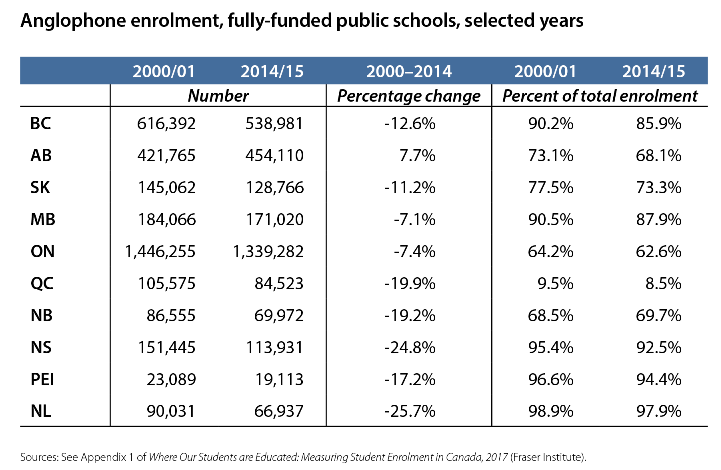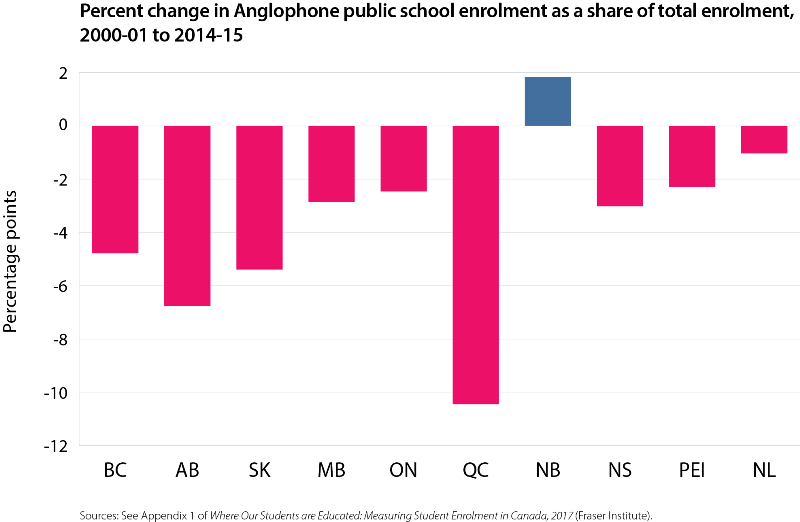Share of students enrolled in anglophone public schools down in almost every province
One of the most important decisions Canadian families make is where their children are educated. Depending on geographical location, families may be able to choose a public school in either official language, a separate Catholic school, an independent school, a charter school, or decide to educate their children themselves through homeschooling.
While the majority of students are still educated in public schools in the dominant language of their area (French in Quebec, English in the other nine provinces), more and more families are looking at alternatives.
When we consider student enrolment across the country, the most logical place to begin is anglophone, or English-language public schools. Every province, with the notable exception of Quebec, has multiple anglophone public school boards acting as its primary source of education. However, between 2000-01 and 2014-15, in nine out of 10 provinces, enrolment in anglophone public schools (as measured as a share of total enrolment) has declined.

Newfoundland and Labrador maintains the highest rate of public anglophone education in 2014-15 enrolment at 97.9 per cent. In general, the Atlantic provinces have the highest rates of public anglophone enrolment—bilingual New Brunswick as a notable exception.
Quebec’s 8.5 per cent enrolment in anglophone schools is by far the lowest of any province, as is expected with French being Quebec’s official language. In addition, the Government of Quebec places restrictions on students attending anglophone schools in the province. Other than Quebec, Ontario has the lowest rate of public anglophone enrolment at 62.6 per cent.
In terms of the absolute numbers of students enrolled in anglophone public schools, there has been an overall decline in enrolment since 2000-01. Every province except Alberta experienced a decline in the absolute number of students enrolled in public anglophone schools. Newfoundland and Labrador experienced the largest decline of 25.7 per cent, while Manitoba experienced the smallest decline of 7.1 per cent.

Nine of the 10 provinces experienced a decline in public anglophone enrolment as a share of total enrolment between 2000-01 and 2014-15. Quebec recorded the largest decline of 10.4 per cent, from 9.5 per cent of total enrolment in 2000-01 to 8.5 per cent in 2014-15. Alberta has the second largest decline of 6.8 per cent in the share of total enrolment, from 73.1 per cent in 2000-01 to 68.1 per cent in 2014-15 despite being the only province to have increased its absolute number of enrolment.
Newfoundland and Labrador had the smallest decline, 1.0 per cent of total enrolment, from 98.9 per cent in 2000-01 to 97.9 per cent in 2014-15. Only New Brunswick recorded an increase in the share of students attending an anglophone public school, increasing from 68.5 per cent to 69.7 per cent.

Although anglophone public schools still remain the dominant form of schooling in Canada, increasingly families are looking at options beyond their neighbourhood public school for the education of their children.
Author:
Subscribe to the Fraser Institute
Get the latest news from the Fraser Institute on the latest research studies, news and events.

